
The 7-string guitar expands the tonal range of traditional guitars, adding a lower string for deeper notes and enhanced versatility. Popular in metal, jazz, and progressive genres, it offers players unique sonic possibilities while maintaining familiar playability, making it accessible to both beginners and experienced musicians.
What is a 7-String Guitar?
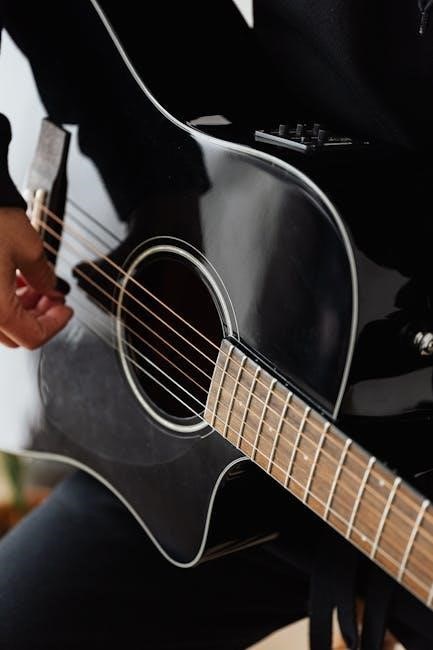
A 7-string guitar is an electric or acoustic guitar featuring seven strings instead of the standard six, typically adding a lower-pitched string to expand the instrument’s tonal range. The additional string, usually tuned to a lower note (commonly A or B), provides deeper bass tones and enhanced versatility for complex musical styles. While it retains the familiar layout of a standard guitar, the extra string introduces new possibilities for chord voicings, scales, and harmonic exploration. It is particularly popular among metal, jazz, and progressive musicians who seek extended range and unique sonic textures. The 7-string guitar requires slight adjustments in playing technique but remains accessible to both beginners and experienced players looking to explore new musical dimensions.

History and Evolution of the 7-String Guitar
The 7-string guitar has its roots in the late 19th century when Russian guitarist Andrei Sychra first introduced the concept. It gained popularity in the early 20th century, particularly among jazz musicians seeking extended harmonic possibilities. In the 1980s and 1990s, the 7-string guitar experienced a resurgence, driven by progressive and metal musicians like Steve Vai and Korn’s James “Munky” Shaffer. This era saw the instrument become a staple in modern music, offering players a broader tonal palette. The evolution of the 7-string guitar reflects its adaptability to diverse musical styles, from classical compositions to contemporary heavy metal, making it a versatile tool for innovative artists.
Why Choose a 7-String Guitar?
The 7-string guitar offers a compelling choice for musicians seeking to expand their creative horizons. Its additional string provides a deeper tonal range, allowing for richer bass lines and intricate chord voicings. This makes it particularly appealing to players in genres like metal, jazz, and progressive music, where complexity and depth are valued. Unlike traditional 6-string guitars, the 7-string enables exploration of uncharted harmonic territories, offering fresh possibilities for composition and improvisation. For those looking to stand out or diversify their sound, the 7-string guitar is an inspiring and versatile instrument that opens doors to new musical expression and innovation. It’s ideal for both experienced players and adventurous beginners eager to explore beyond conventional boundaries.
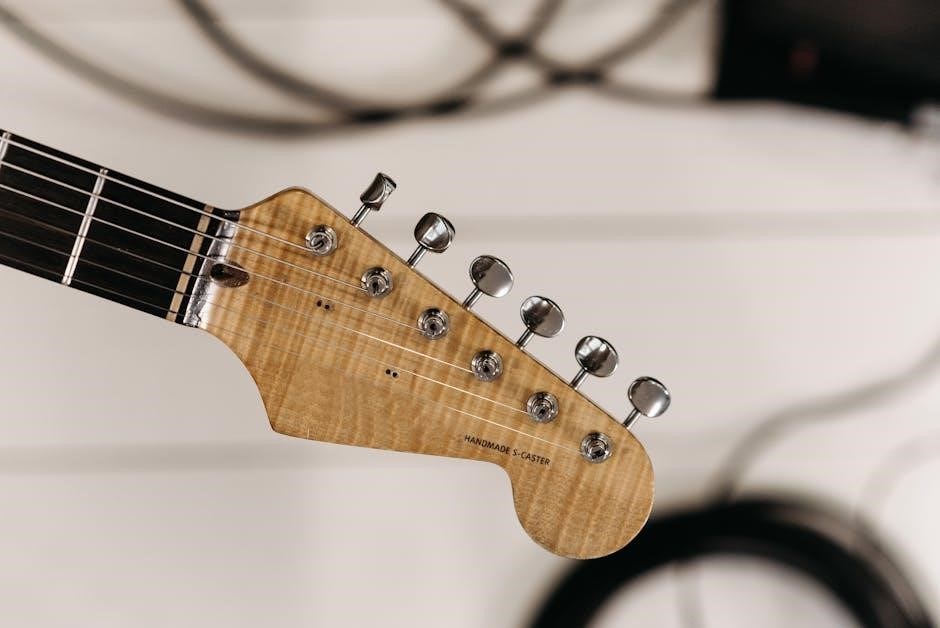
Tuning and Setup
Proper tuning and setup are crucial for optimal playability and sound. Adjust the truss rod for frets 1-12 and the bridge for frets beyond the 12th fret, ensuring precise tuning and smooth performance across the fretboard.
Standard Tuning for a 7-String Guitar
Standard tuning for a 7-string guitar typically involves adding a lower-pitched string, often tuned to A or B, below the standard E-A-D-G-B-E tuning. The most common setup is A-D-G-B-e-B-A or B-E-A-D-G-B-E, providing a deeper tonal range. This tuning is ideal for genres like metal and jazz, where extended bass notes enhance the sound. For beginners, starting with standard tuning allows familiarity with chord shapes and scales similar to a 6-string guitar. Adjustments may require tweaking the truss rod and bridge to maintain proper playability. Using heavier string gauges for the lower tunings ensures clarity and avoids muddiness. Experimenting with string gauges can help achieve the desired tone. Proper setup and tuning are essential for maximizing the 7-string guitar’s versatility and sound quality.
Alternative Tunings and Their Uses
Alternative tunings for the 7-string guitar unlock a wide range of tonal possibilities, catering to specific musical styles and creative needs. Open A (A-E-A-C#-E-G#) and Drop A (A-D-G-B-e-B-A) are popular choices for heavy, distorted sounds in metal music. Double Drop tunings, like B-F#-B-E-G#-C#, offer a deeper, heavier tone for aggressive playing. Jazz and progressive musicians often use tunings like C-G-C-G-D-A for extended harmonic options. Alternative tunings allow players to explore unique chord voicings and scale patterns, adding depth to compositions. Experimenting with these tunings can inspire creativity and adaptability, making the 7-string guitar a versatile tool for various genres. Proper string selection is crucial to maintain clarity and playability in lower tunings.
Adjusting the Truss Rod and Bridge
Proper adjustment of the truss rod and bridge is essential for optimal playability and tone on a 7-string guitar. The truss rod controls neck relief, ensuring the neck remains straight or slightly concave under string tension. Adjustments are typically made at the headstock or heel, using an Allen wrench. For issues beyond the 12th fret, the bridge is adjusted to lower or raise the string action. For the first 12 frets, tweaking the truss rod is necessary. A rule of thumb is to adjust the truss rod for neck relief and the bridge for string height. Regular maintenance ensures proper intonation and prevents buzzing or fretting out. Always use the correct tools and make small, incremental adjustments to avoid damaging the instrument;
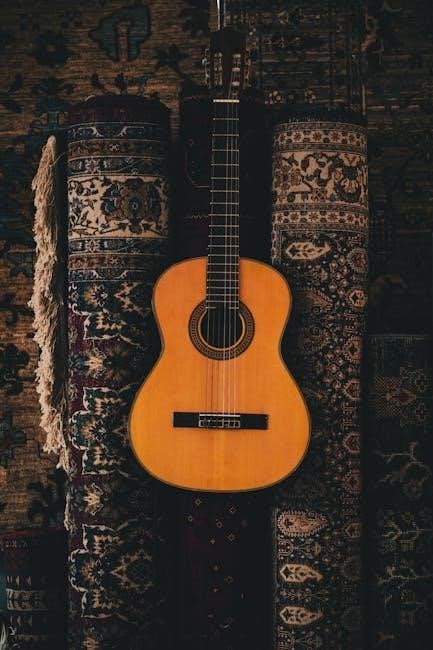
Choosing the Right Strings
Selecting the right strings for your 7-string guitar is crucial for tone and playability. Lighter gauges offer easier bending, while heavier gauges provide better sustain and clarity. Materials like steel, nickel, or nylon significantly impact the sound quality, allowing players to tailor their tone to suit their style and genre.
String Gauge and Playability
String gauge significantly impacts the playability and tone of a 7-string guitar. Lighter gauges (e.g., 0.009-0.052) are easier on the fingers, ideal for bending and fast solos, while heavier gauges (e.g., 0.011-0.065) offer better sustain and clarity. Players with a lighter touch may prefer lighter strings for comfort, especially when navigating lower tunings. However, heavier strings are often favored for metal and hard-hitting genres due to their durability and resonance. Experimenting with different gauges helps find the perfect balance between playability and tone. Proper setup, including truss rod and bridge adjustments, ensures optimal performance regardless of gauge choice. This balance is key for both beginners and experienced musicians to achieve their desired sound and playing experience.
Materials and Their Impact on Sound
The materials used in a 7-string guitar significantly influence its tone and playability. String materials like nickel, stainless steel, and titanium offer distinct sonic characteristics. Nickel-plated strings provide a warm, vintage tone with smooth playability, while stainless steel strings deliver brightness and durability. Coated strings, such as those with a polymer layer, reduce finger noise and corrosion but may slightly dampen high-end clarity; The choice of materials also affects sustain and resonance, with heavier gauges often producing fuller tones. Additionally, the guitar’s body and neck woods, such as mahogany or maple, contribute to the overall sound profile. Experimenting with different materials helps players achieve their desired tonal preferences, whether for metal, jazz, or other genres. This customization ensures the 7-string guitar meets individual musical needs effectively.
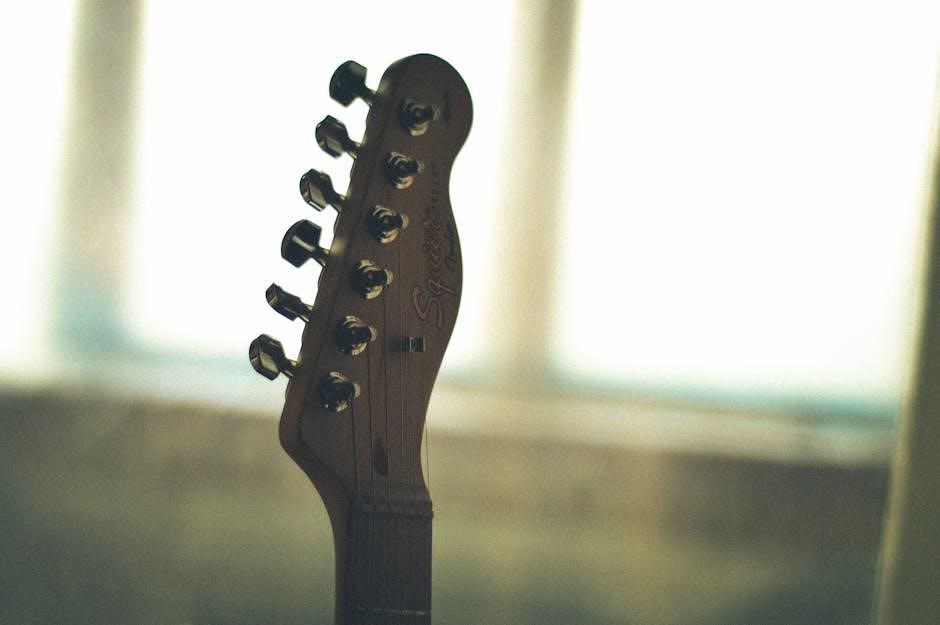
Playing Techniques
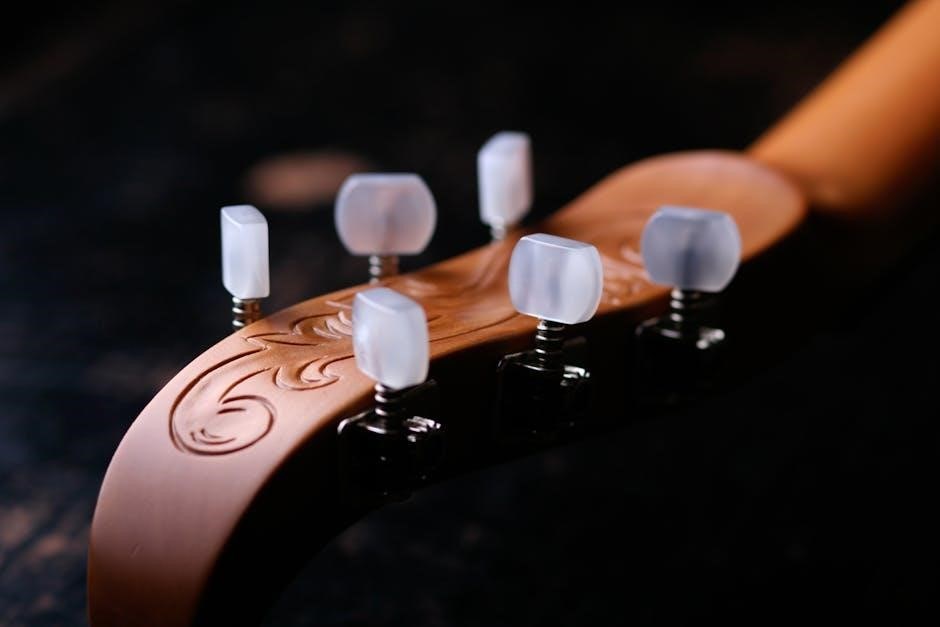
Mastering legato and tapping techniques on a 7-string guitar unlocks intricate melodies and fluid solos, while sweep picking enhances arpeggio playing, expanding your tonal and dynamic range.
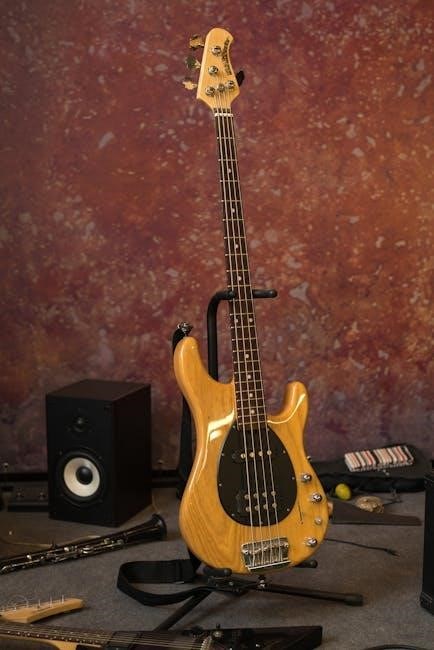
Chords and Scales on a 7-String Guitar
The 7-string guitar introduces an additional low string, expanding the range for chords and scales. While standard chords can be adapted, the extra string allows for extended voicings and deeper tones. Scales like the pentatonic and major/minor scales gain new dimensions, enabling intricate melodies. Beginners can start with familiar shapes on the higher strings, gradually incorporating the low string for added depth. Understanding guitar tabs and online resources can simplify learning. Regular practice strengthens finger dexterity, essential for navigating the wider fretboard. With time, players can master complex chord progressions and scales, unlocking the 7-string’s full potential for versatile and dynamic music creation.
Legato and Tapping Techniques
Legato and tapping techniques on a 7-string guitar offer new possibilities for expressive playing. Legato playing benefits from the extended range, allowing smooth transitions between notes across the fretboard. Tapping, which involves both hands on the fretboard, can create intricate, lightning-fast phrases. The additional string provides more room for complex patterns, especially in metal and progressive music. To master these techniques, focus on building finger strength and coordination. Start with slower tempos and gradually increase speed. Using a metronome can help improve timing accuracy. Legato and tapping are advanced methods that, when mastered, add a unique dimension to your playing style, making the 7-string guitar a powerful tool for musical expression.
Hardware and Setup Tips
Optimize your 7-string guitar’s playability by adjusting the bridge and nut for proper string action. Ensure pickups are correctly spaced for balanced tone and output efficiency.
Bridge and Nut Setup for Optimal Playability
Proper bridge and nut setup is crucial for a 7-string guitar to ensure smooth playability and clear tone. The bridge adjusts string action (height) beyond the 12th fret, while the nut handles action from the 1st to the 12th fret. Lowering the bridge or nut can reduce string height, but be cautious not to compromise playability or cause buzzing. Use a ruler to measure action at the 12th fret and 1st fret, ensuring evenness across all strings. For optimal results, use an Allen wrench to fine-tune the bridge and a precision tool for the nut. Proper setup prevents buzzing, enhances clarity, and makes playing more comfortable, especially for complex techniques like tapping or legato.
Pickups and Tone Optimization
Pickups are a critical component of the 7-string guitar, directly influencing its tone and versatility. Humbucker pickups are often preferred due to their ability to handle lower tunings without hum or noise. Single-coil pickups, while brighter, can introduce hum but offer a distinct tonal clarity. The choice of pickup material, such as Alnico magnets, impacts warmth and articulation. Players can experiment with active pickups for higher output and clarity, especially in heavy genres like metal. Proper pickup height adjustment ensures balanced tone and prevents muddiness. Using a screwdriver, raise or lower pickups to achieve optimal string response. Bridge pickups provide brightness for leads, while neck pickups deliver warmth for rhythms. Fine-tuning these elements enhances overall tone, making the 7-string guitar a versatile instrument for diverse musical styles.
Learning and Resources
Mastering the 7-string guitar requires dedication and the right resources. Online courses, video tutorials, and practice guides tailored to extended-range guitars can accelerate learning. Join forums and communities for tips and inspiration, ensuring a well-rounded musical journey.
A Beginner’s Guide to Getting Started
Starting with a 7-string guitar can seem daunting, but breaking it down into manageable steps makes the journey enjoyable. Begin by familiarizing yourself with the instrument’s layout, focusing on the extra string and its tuning. Practice basic chords and scales within the first four frets to build finger strength and confidence. Online tutorials and video guides are invaluable for visual learners, while structured lessons can provide a clear progression path. Experiment with simple riffs and songs to apply your skills creatively; Regular practice, even for short sessions, is key to improving technique. Joining forums or communities can offer support and inspiration, helping you stay motivated as you explore the unique possibilities of the 7-string guitar.
Recommended Books, Videos, and Online Courses
For mastering the 7-string guitar, several resources stand out as essential. Books like The Hal Leonard Guitar Method offer foundational lessons, while The Guitar Handbook provides in-depth insights into guitar mechanics and playing techniques. Online, channels like GuitarLessons365 and Marty Music provide clear, step-by-step tutorials tailored for 7-string players. Platforms like TrueFire and Guitar Tricks host comprehensive courses covering genres from metal to jazz. Additionally, forums and communities, such as Ultimate Guitar, share user-generated tabs and lessons. When choosing resources, prioritize those with structured lesson plans and interactive elements to enhance learning. Reviews and previews can help identify the best fit for your skill level and musical interests.